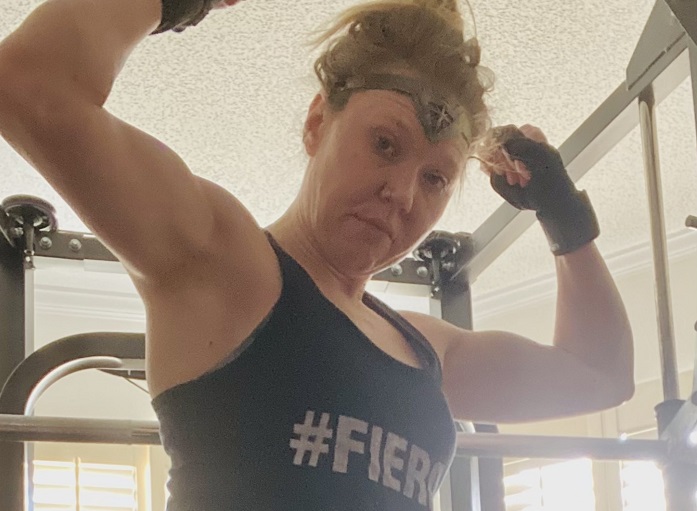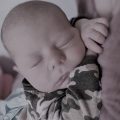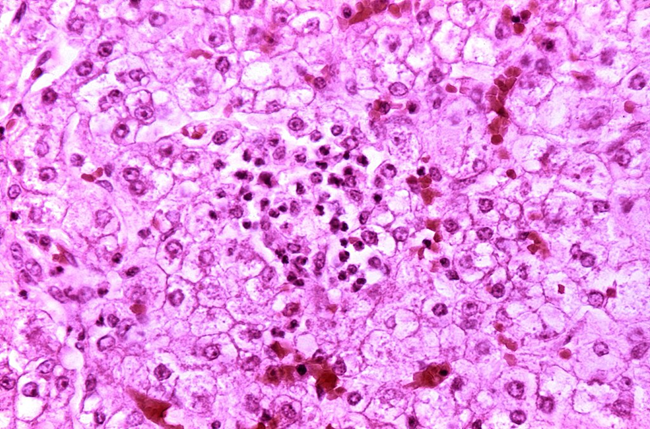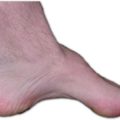At age 23 I attempted suicide after years of mental and physical self-destruction. Something inside of me assumed the position of thinking that life was nothing but unbearable suffering and misery; that all was lost and there was no hope or joy to be found. Looking back, the fact that I even entertained that way of thinking astounds me. I do not say this jokingly but I am fortunate that rather than dying, as was predicted, I suffered a massive stroke that affected my cerebellum. This left me unable to move, but I lived. Often, what are seemingly our darkest days are a gift. If I hadn’t lost the ability to move and continued to physically ply myself with alcohol, drugs, food, cigarettes, etc., I would have surely died incredibly quickly. If I did not have that year of immobility and inability to move my arms, I am sure I would have very quickly perished by another means, probably self-inflicted. I am grateful for all the heartache and the pain. It has made me who I am and helped me find strength. Without a cerebellar brain injury and the hard work it has taken to face it, I wouldn’t be alive to tell my story. That sounds odd, but trust that it is true. I pray you may find my story inspirational.
Every Story Has a Beginning
I lay comatose in my still hospital room with the sound of whirring machines and regular beeps from hospital equipment the only noise in otherwise silence. Incessant beeps from the EKG monitoring my weakened heart broke the thick stillness that was my current home. I resembled Frankenstein’s monster with all the wires and IVs protruding from veins and arteries throughout my emaciated, anorexic body. It was Thanksgiving and wearily, my grief-stricken family decided that they should possibly should possibly have some Thanksgiving dinner. My family could not travel far from my room, on the off chance I passed away and they were not on hand. The hospital cafeteria would have to do. This was hardly how they imagined this holiday turning out. The wounds left by my father’s suicide were still fresh. My family’s still beating hearts were now on display for everyone to see. Such familial tragedy was unheard outside of books and film.
So they prayed with all they could muster, which was not much; prayed that somehow, someway my completely ravaged body would miraculously pull through and actually revive itself back to life. They had little hope. The medical team had prepared them for my demise. This scenario was familiar to them. I had, to date, 5 suicide attempts and many ambulance rides, ERs. ICUs, hospitals, jails, rehabs, psychiatric wards, and treatment center stays since age fifteen. I had recently turned 23. The chances did not look altogether well that I would reach my 24th birthday. Only an act of providence would save me from my fate now.
My extended family had traveled from as far away as Pennsylvania and North Carolina to offer my mother and siblings support and to be with them while they grieved. Sweet whispers graced my ears with the hopes that, by chance, I would subconsciously receive these messages. I believe in my heart, that I did. I believe that everyone’s prayers came to fruition. I believe in miracles. There is no other way to explain what was about to bring shock to everyone involved. As they prayed for some sort of miracle, on a bleak Thanksgiving, in the cafeteria of a random hospital in Winchester, Virginia, all prayers were answered. I woke up.
The medical staff interrupted their prayer vigil with the incredible news. I had just regained consciousness. As they prayed for me over their Thanksgiving meal, I slowly opened my eyes. I believe, now, that prayers are miraculous if they are sincere. God performed a true miracle on that day. The fact that it was Thanksgiving Day is enough to incur shock and awe from anyone who is aware of this scenario. This was my rebirth, the day I cheated death. To say this was by far the most miraculous day of my life would be a massive understatement.
It Is Always Darkest Before Dawn: Learning To Live With Cerebellar Injury
Thus began my neurological downfall. It would be too simple if that was all, wouldn’t it? Neurological issues are complex. They are not even remotely simple. After the cerebellar stroke and my two week coma, I was transported by a non-emergency ambulance to a physical rehabilitation center, primarily with patients there for numerous neurological issues. I had severe dysphagia –the inability to swallow. Because of the dysphagia, I had regular cameras shoved up my nose and down the back of my throat. Luckily, they were coated in KY jelly to soften the shock. Having lost all muscle control, I had to be rolled onto a tarp and be hoisted in the air to gather my weight. I looked like a fish you’d see on the side of a pier. I was forced to play connect four during therapy sessions to work on my fine motor coordination. At first, I could not manage to pick up a single chip. I had depleted the oxygen in my cerebellum so severely that is was now around 1/3 the average size.
If there is one thing to know about me it is this: I do not even remotely appreciate being told what I can or cannot do. So when they told me that I would spend my entire life in an assisted living facility and would never walk again, I had to make a choice. I decided they were wrong and that I would walk again and live on me on my own. So I fought and was prepared to fight to regain my life. After all, I woke up from a coma on Thanksgiving Day. This was no different. I was prepared to get my life back.
Thus Begins My Defiance of My Doctors: Simultaneously Battling Physical and Mental Illness
I do not think my therapists expected what they got from me. If they gave me home exercises, I did them twice to improve twice as well. It took me close to a year to actually verbally communicate again, but I was quite incoherent. It took close to 7 years for people to actually understand what I was saying. I spent my first 3 years post-stroke convalescing in my mother’s home. My family steadfastly believed in me and supported me. My mother and siblings surprised with a fancy recumbent bicycle that I could keep in the living room, near my chair so I could hobble over to it with my walker. They wanted to surprise me with something that would help rebuild my leg muscles.
I remember doing hours of wall sits. I once tried to do the in the dining room and was straining very hard. The carpet scooted forward and my feet flew out from under me. I landed squarely on my tailbone. My family somehow got me into their car and transported me to the nearest medcare center. Luckily it was not broken, but I spent the next 2 weeks lying sideways on the living room couch in sheer misery. Fortunately, there was not a huge amount of force on my tailbone, as I was battling anorexia nervosa at the time and did not have very much mass. This was also of year of my favorite potato starch thickener. This is what they give to patient in nursing homes with dysphagia so that they do not aspirate fluid into their lungs and wind up with sever pneumonia. I had to add this to all my drinks. Coffee and water took on the constituency of pudding.
I was also severely mentally ill and was unable to take any psychiatric medication. Add to that, I was drinking a liter of vodka daily and using heroin and cocaine before my stroke. Suffering from untreated mental illness, substance abuse, an eating disorder, a severe disability, and issues with self-mutilation is not exactly a cake walk. Somehow, thankfully, at this point in my life, I had to realize that this was my current physical situation and that no amount of praying or wishing it was different would change a damn thing. I was here… now I was here… nothing would change that except hard work on my part. I learned that recovery was a process and that there is no finish line. It is something you have to constantly put effort into if you want to grow and progress. Was it easy?? HELL no! Worth every single second of misery and struggle? Without a doubt!!
The Courage To Be Strong and Happy
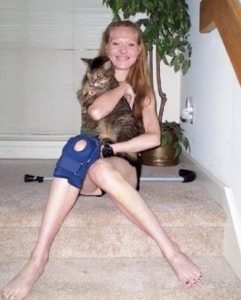
Fortunately, yes, fortunately, I did not feel as though that was enough. Shortly after I believed I was healing, I went back to my old behaviors. I had experienced the joy in life and it was unbearable. My motto was that pain is comfortable. Happiness scared me. On December 15, 2013 I said: ENOUGH! I decided I was willing to do ANYTHING! I had worked so damn hard to regain my life, if I did not give my heart and soul to my life, I knew I’d die. And that was not worth anything. If I had to scream and cry, if I could not stand the mental or physical torment, I would face it with all the courage I could bring forth. I’m glad to say that I have been sober and eating disorder free as well as mentally stable for years now. If there is one thing I know with certainty, it is that life has many hurdles. When you trip over one, you have a choice between staying on the ground or standing up and brushing yourself off. You will see now how, when you are determined as HELL, NOTHING can stop you.
From Soup Cans to Barbells and Patient to Trainer
Shortly after I got sober, I decided I was not just going to live and walk again. I was going full throttle. I worked full days at GNC using my walker and spent my spare time every day at the local gym. I thrived amongst weights. I decided to become a personal trainer, with my walker if I had to. I had risen from a pile of ashes. I no longer believed anything was impossible. I enrolled at NASM and then I thought, I am not stopping there and so I also enrolled in courses to train senior citizens and to become a certified corrective exercise specialist. Several years later, I became certified to train clients with Parkinson’s disease.
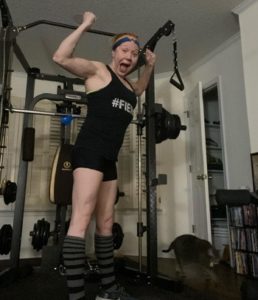
Not long after sitting through a proctored exam and passing it easily, I had a talk with my stepfather (who is really my dad). He also believes in achieving the impossible and has consistently done it himself. I asked him what big thing I should attempt next. He suggested I try the Paralympics. I thought “That might be the most insane thing someone’s ever suggested to me! I used to weigh 80 pounds and eat sugar free gum for dinner!” Then I realized that I had actually been insane and that it was time to become “good” insane! I want to inspire others through example; to show others with physical disabilities that if someone like ME can use exercise to vastly improve their physical situation, they ABSOLUTELY can too. I have people tell me I work too hard but it’s not up to them, is it? So I got to work. As is the case with me, the universe decided it was not yet done challenging me.
In January of 2020, I was told my cerebellum was now 75% too small and I might possibly have congenital ataxia. I have yet to see specialists, and honestly, I am not concerned right now. My physical training is making me better and any negative diagnosis is null and void to me. I carefully listen to my doctors, but they are fallible. Every human being is fallible. So I will keep going, whatever challenge I face. I know what giving up on yourself is like. It is a feeling I would not wish on my worst enemy. I will not give up. No one will limit me or make me feel small because of my condition. Medicine does not measure the human spirit. Guess what? I can now walk holding walker with 25 pound weight plates inside of it. I can deadlift 190 pounds and squat a 180 pound barbell. I began this journey lifting soup cans. Soup cans! If you’re struggling physically, remember that I started with curling soup cans in a wheelchair and now can lift almost 200lbs.
Final Thoughts
I would absolutely never change the fact that I am disabled. It has changed my life for the better. It has taught me responsibility, a sense of awe of how difficult things are for some people, and gratitude for literally everything. Every minute I exist, everything I am, is a gift. I absolutely REFUSE to waste it. When everything you believed was important and everything you took for granted is taken away from you, you realize at some point that you are at a crossroads. Either give up and literally die or accept your lot with dignity and grace. I do not know what my future holds, but you can be damned certain that I am not going down without a fight! We all have choice. Many things are beyond my control, the effort I put towards my physical self is absolutely up to me!
We Need Your Help
More people than ever are reading Hormones Matter, a testament to the need for independent voices in health and medicine. We are not funded and accept limited advertising. Unlike many health sites, we don’t force you to purchase a subscription. We believe health information should be open to all. If you read Hormones Matter, like it, please help support it. Contribute now.
